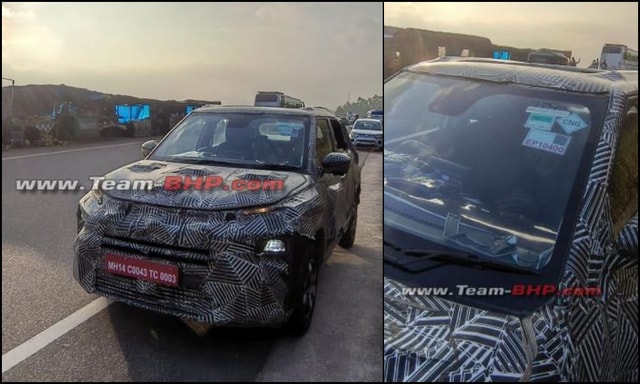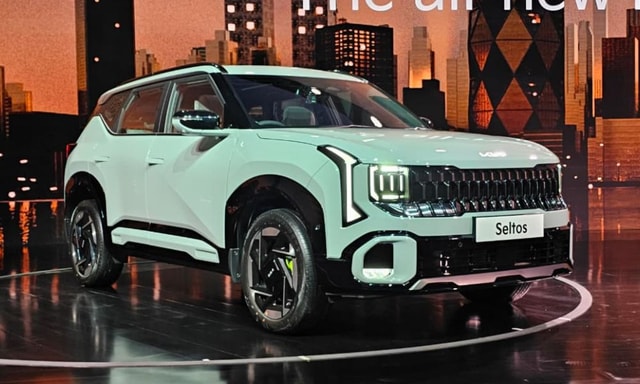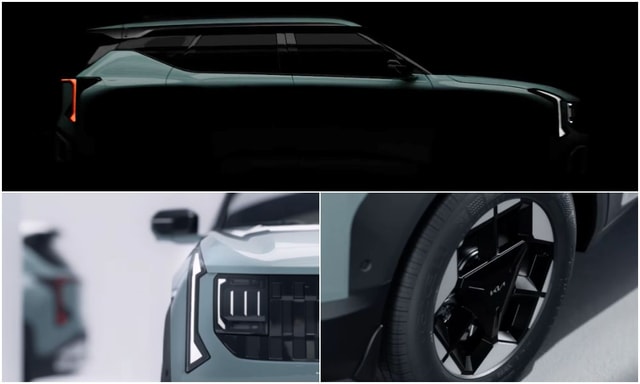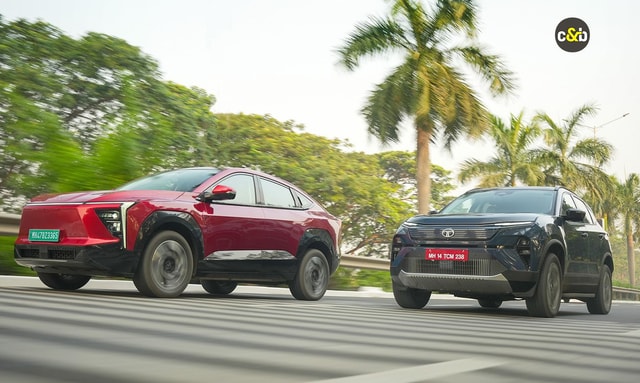Toyota Fortuner Neo Drive 48V Mild Hybrid Review: Familiar Performance, Minor Gains

- Fortuner & Legender Neo Drive now gets Toyota's 48V mild-hybrid tech
- Mild hybrid tech has improved acceleration and efficiency
- Neo Drive is only offered with the 4x4 diesel automatic variants of the SUVs
The Toyota Fortuner is one of those rare models that have built lasting loyalty among SUV buyers in India. It’s a name that has outgrown its brand and continues to set the benchmark in the segment. So, when Toyota introduces something new with the Fortuner, it naturally draws attention. This time, it’s the addition of a mild-hybrid variant. Yes, the Fortuner and Fortuner Legender are now available with 48-Volt mild-hybrid tech, branded as Neo Drive.
The Fortuner and Legender Neo Drive now get Toyota's 48V mild-hybrid tech
Toyota announced the Neo Drive lineup over a month ago, but we only recently got behind its wheel. So, has the 48V system made a meaningful difference? Should you consider adding one to your garage, or ignore the hype and explore entry-level luxury cars instead? Let’s find out.
Performance: Any Better?
No change in power figures from the 2.8-litre diesel engine - 201 bhp & 500 Nm
Toyota says the Neo Drive system brings three main benefits: smoother acceleration, better fuel efficiency, and a more refined drive experience. Under the hood, the Fortuner still uses the same 2.8-litre diesel engine with 201 bhp and 500 Nm of torque. There’s no change in peak output. However, it replaces the traditional alternator with a belt-integrated starter generator powered by a 48V lithium-ion battery.
Mild-hybrid system smoothens out the initial turbo lag, adds 16-17 bhp worth of assist at low revs
This system delivers a temporary boost of about 16–17 bhp, not added to the total output but used to smooth out initial turbo lag. As a result, acceleration feels cleaner and quicker, especially at lower revs. In our short test, the Fortuner hit 100 kmph in about 11 seconds, reasonable for a 2.8-tonne SUV. Overall, it still feels as punchy, but now with a marginally smoother power delivery.
Also Read: Toyota Fortuner Neo Drive Mild-Hybrid Launched In India At Rs 44.72 Lakh
Efficiency: Any Gains?
Toyota claims a range bump of up to 43 km on a full tank
The Neo Drive system adds idle start-stop and assists during cruising, which helps reduce engine load and thus helps it run efficiently. In fact, Toyota claims the 48V mild hybrid setup extends the SUV’s total range by 43 km on a full tank. Toyota hasn’t released a certified fuel efficiency figure, and our brief drive showed around 7.5 kmpl on the display. With an 80-litre tank, that works out to 600 km.
On-road performance remains largely familiar, but feels slightly better
Now, typically, the Fortuner delivers 10–14 kmpl, translating to 800–1000 km range under ideal conditions. However, we’ll need more time and proper conditions to confirm real-world gains, but the tech does bring marginal improvements, at least on paper.
What’s New In Features?
On the outside, the only visual change is the Neo Drive badge on the tailgate
Now, the model I got to test was the Toyota Fortuner Legender Neo Drive, which is the sportier and more premium variant of the SUV. However, except for the addition of the Neo Drive badge on the tailgate, visually, nothing has changed.
Dual-tone cabin continues in the Legender variant, but ventilated front seats are no longer on offer
Inside, the cabin remains largely the same. The Legender continues with dual-tone black and maroon upholstery, while the Fortuner Neo Drive gets an all-black theme.
Familiar dashboard layout with no visual changes
One notable downgrade: ventilated front seats have been removed. Toyota says this is mainly due to the placement of the DC-DC converter module, which is underneath the front passenger seat. Could the company have found a better solution to this? Well, I surely think so! However, the good thing is, other variants of the SUV, without the mild-hybrid tech, will continue to offer cooled seats.
Also Read: Toyota Fortuner, Legender Prices Hiked By Up To Rs 68,000
New 360-degree camera added to the feature list, but camera clarity could have been better
That said, a few useful upgrades have arrived. A 360-degree camera is now part of the package—a long-pending addition. The camera quality isn’t exceptional, likely due to the dated infotainment screen, but it works well.
No wireless Android Auto and Apple CarPlay, but Fortuner gets a wireless charger
Wireless Android Auto and Apple CarPlay are still missing, requiring a USB Type-A cable. On the plus side, the standard Fortuner Neo Drive now gets a wireless charger; earlier, only the Legender got it. The JBL sound system continues to perform well.
Terrain Tech: Added Confidence Off-Road
Multi-Terrain System adds five off-road modes
As part of the feature upgrades, the Neo Drive variants now also come with a Multi-Terrain System (MTS), which is another welcome addition in my books. You get up to 5 different terrain modes – Mud, Sand, Rock, Dirt, and Deep Snow. The system complements the Fortuner’s capable 4x4 system and gives you measured power delivery depending on the terrain.
Neo Drive replaces standard 4x4 automatic variants
However, as mentioned, I had very limited time with the SUV, so we couldn’t test the new MTS properly. So, please wait for our proper road test for a more detailed report on the terrain management system.
Price & Verdict
Fortuner Neo Drive starts at Rs 44.72 lakh ex-showroom, and Platinum White Pearl colour costs an additional Rs 15,000
The Neo Drive variants replace the standard 4x4 diesel automatic trims. Prices start at Rs. 44.72 lakh for the Fortuner and Rs. 50.09 lakh for the Legender (ex-showroom). That’s around Rs. 2 lakh more than the trims they replace. And if you want the Platinum White Pearl shade, you’ll have to pay another Rs. 15,000. So, is the price hike justified? If we go purely by logic, probably not. The features list needs a proper overhaul to keep up with what buyers expect at this price.
For loyalists, the Neo Drive adds a new badge and some tech, but keeps the old-school Fortuner spirit intact
But logic doesn’t always apply to the Fortuner. This is a model that continues to sell around 3,000 units every month, despite its age and premium pricing. And it likely will until Toyota brings in an all-new generation. It might not make sense on paper, but these small yet meaningful updates do make the Fortuner slightly better to live with, without taking away what fans love most about it. In a nutshell, if you want a diesel automatic 4x4 Fortuner or Legender, the Neo Drive variant is now your only choice, and it’s not a bad one.
Photos: Vaibhav Dhanawade
Trending News
 10 mins readTata Sierra Review: India’s New Favourite?
10 mins readTata Sierra Review: India’s New Favourite?
Latest News
 car&bike Team | Dec 10, 2025Aston Martin Launches Watch Collection With Timex, Prices Start At Rs. 17,995The collection brings Aston Martin’s iconic design language from road to wrist through two pillars along with automotive-inspired detailing.1 min read
car&bike Team | Dec 10, 2025Aston Martin Launches Watch Collection With Timex, Prices Start At Rs. 17,995The collection brings Aston Martin’s iconic design language from road to wrist through two pillars along with automotive-inspired detailing.1 min read car&bike Team | Dec 10, 2025Facelifted Tata Punch CNG Spied Testing Ahead Of DebutCompared to previous spyshots of the Punch facelift, the CNG vehicle here looks to have missed out on some kit.1 min read
car&bike Team | Dec 10, 2025Facelifted Tata Punch CNG Spied Testing Ahead Of DebutCompared to previous spyshots of the Punch facelift, the CNG vehicle here looks to have missed out on some kit.1 min read Seshan Vijayraghvan | Dec 10, 2025All-New Kia Seltos Unveiled: A Detailed Look In PicturesBookings for the new Kia Seltos will commence from December 11, while the price announcement will happen on January 2, 2026.2 mins read
Seshan Vijayraghvan | Dec 10, 2025All-New Kia Seltos Unveiled: A Detailed Look In PicturesBookings for the new Kia Seltos will commence from December 11, while the price announcement will happen on January 2, 2026.2 mins read Jaiveer Mehra | Dec 10, 20252026 Kia Seltos Makes Global Debut; India Launch On January 2, 2026Second-gen Seltos debuts Kia’s latest design language with design elements borrowed from the new Telluride SUV.4 mins read
Jaiveer Mehra | Dec 10, 20252026 Kia Seltos Makes Global Debut; India Launch On January 2, 2026Second-gen Seltos debuts Kia’s latest design language with design elements borrowed from the new Telluride SUV.4 mins read car&bike Team | Dec 10, 20252026 Kia Seltos World Premiere Highlights: Specifications, Features, Images1 min read
car&bike Team | Dec 10, 20252026 Kia Seltos World Premiere Highlights: Specifications, Features, Images1 min read car&bike Team | Dec 10, 20252026 Kia Seltos World Premiere In India Today: What To Expect From Gen 2 SUVOne of the most popular compact SUVs on sale in India is about to undergo a complete transformation as it enters its second generation in 2026. Here's all we know about the new Kia Seltos so far.3 mins read
car&bike Team | Dec 10, 20252026 Kia Seltos World Premiere In India Today: What To Expect From Gen 2 SUVOne of the most popular compact SUVs on sale in India is about to undergo a complete transformation as it enters its second generation in 2026. Here's all we know about the new Kia Seltos so far.3 mins read
 Shams Raza Naqvi | Dec 10, 20252025 Mini Cooper Convertible Review: More Colour On Indian RoadsThe updated Mini Cooper Convertible is set to be launched in the Indian market in the next few days. We drive it around Jaisalmer for a quick review.1 min read
Shams Raza Naqvi | Dec 10, 20252025 Mini Cooper Convertible Review: More Colour On Indian RoadsThe updated Mini Cooper Convertible is set to be launched in the Indian market in the next few days. We drive it around Jaisalmer for a quick review.1 min read Bilal Firfiray | Dec 8, 2025Tata Sierra Review: India’s New Favourite?Marking its return after a few decades, the reborn Sierra has made everyone sit up and take notice. But is it worth the hype?10 mins read
Bilal Firfiray | Dec 8, 2025Tata Sierra Review: India’s New Favourite?Marking its return after a few decades, the reborn Sierra has made everyone sit up and take notice. But is it worth the hype?10 mins read Girish Karkera | Dec 4, 20252026 Honda Prelude First Drive: Domesticated Civic Type RA sporty-looking coupe built to give customers a taste of performance but not at the expense of everyday practicality.5 mins read
Girish Karkera | Dec 4, 20252026 Honda Prelude First Drive: Domesticated Civic Type RA sporty-looking coupe built to give customers a taste of performance but not at the expense of everyday practicality.5 mins read Seshan Vijayraghvan | Nov 29, 2025Mahindra XEV 9S First Drive Review: Big Electric SUV, Bigger ExpectationsThe XEV 9S lands at a time when the EV crowd is growing fast. It’s a big, born-electric, three-row SUV that starts under 20 lakh. It sits close to the XUV700 in size, but the brief is very different. Here’s what it’s like on the road.11 mins read
Seshan Vijayraghvan | Nov 29, 2025Mahindra XEV 9S First Drive Review: Big Electric SUV, Bigger ExpectationsThe XEV 9S lands at a time when the EV crowd is growing fast. It’s a big, born-electric, three-row SUV that starts under 20 lakh. It sits close to the XUV700 in size, but the brief is very different. Here’s what it’s like on the road.11 mins read Bilal Firfiray | Nov 26, 2025Tata Harrier EV vs Mahindra XEV 9e: Battle Of India’s Electric TitansWhen India made two electric SUVs battle it out, the winner is the buyer. They get a choice to take home what’s best suited for them – and read on to find out which one is better for YOU.1 min read
Bilal Firfiray | Nov 26, 2025Tata Harrier EV vs Mahindra XEV 9e: Battle Of India’s Electric TitansWhen India made two electric SUVs battle it out, the winner is the buyer. They get a choice to take home what’s best suited for them – and read on to find out which one is better for YOU.1 min read











































































































































